Q&A – Ask Neil: August 22, 2024
(Please read these instructions carefully.)
Before you post your question, please look at recent issues to see if someone else has already asked it. You might find your answer there.
How to submit your question…
(Note: You may need to allow a pop-up window to come up in order to get the link for sending your photo(s). If you have already submitted your question and didn’t see the pop-up window, please click here.)
• Click the link provided below to post your question. After you submit your question, a new window will pop up giving you the address to which you can e-mail a SHARP, HIGH-RESOLUTION PHOTO to accompany your question. Please DO NOT SEND THUMBNAIL PHOTOS in case I need to zoom in to see things.
• Click here to post your question.
• Please ONLY POST YOUR QUESTION ONE TIME. We can only accept a set number of questions each week, and when we get duplicates it costs other people their chances.
• One question per reader, please.
• Please use this only for posting questions – not for standard emails.
• Watch for your answer in the following week’s e-gardens.
• I choose those of greatest general interest. For example, plant IDs seldom make the cut.
• I must have your first name or initials.
• I must have your city or county. (Texas is a very large state.)
QUESTION 1
WHAT IS WRONG WITH MY BERMUDAGRASS?
Question: Is this a fungus in my bermudagrass lawn in these two photos? Do I need to spray with a fungicide? Chia Liao, Little Elm.
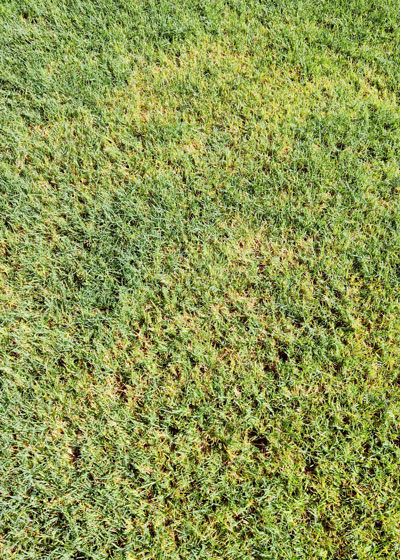
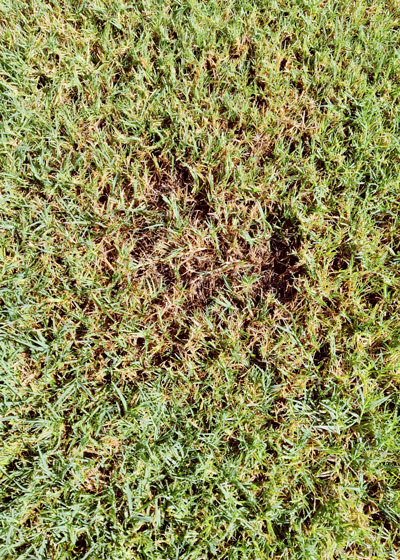
Answer: This does not appear to be a fungal disease of any kind. I have three thoughts. The lawn looks dry, so it may be nothing more than that. It also looks like it probably needs nitrogen, so feeding it with a high-quality, all-nitrogen fertilizer (30 to 40 percent of the nitrogen in slow-release form) followed by a thorough watering should help. (So will cooler weather by early September.)
And the third thing I may be seeing is holes left behind by emergence of cicada killer wasps. If you look closely, you can make out areas about the size of broomsticks through the grass in your photos. Cicada killers are predatory insects that make their nests in the soil. They capture cicadas in mid-summer and return to the holes where they bury the paralyzed insects after placing eggs in their bodies for the next generation of the wasps. I won’t go into a lot more detail here except to say that they are not harmful or dangerous if you leave them alone. (Don’t go digging looking for them.) You’ll see them hovering a few feet above the ground. If that’s been the case, they have probably disturbed the soil enough to disrupt the grass roots a bit. Given water and nutrition it will recover quickly.
QUESTION 2
WHAT HAS HAPPENED SUDDENLY TO MY NELLIE R. STEVENS HOLLY?
Question: What happened to my Nellie R. Stevens holly I planted last fall? I watered it faithfully and it thrived for 10 months. Suddenly it went downhill. It’s within 6 ft. of another healthy Nellie R. Stevens planted 3 years ago. Mary J., Bexar County.
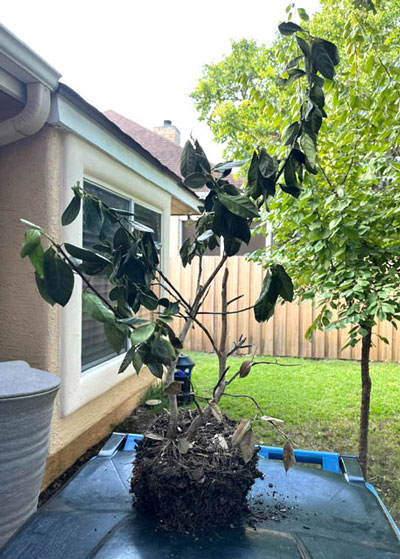
Answer: It got too dry. Guaranteed, I’ve seen this already several hundreds of times. Nothing else gives these symptoms. Because hollies don’t wilt like most other plants it’s easy for them to go past the point of no return without our realizing it. The third-year plant has roots that go much farther out into the surrounding soil.
QUESTION 3
WHAT IS THE WHITE FUNGUS ON OUR PRIVET?
Question: We have a large type of privet in our backyard. The bushes have become covered in a white fungus. It’s on their trunks and leaves. What will stop its spread onto our other privet plants? Debbie E., McKinney.
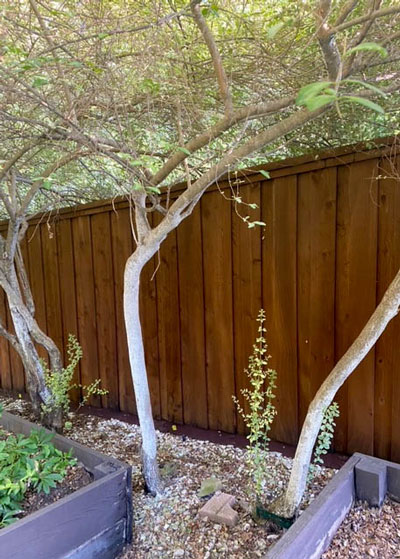
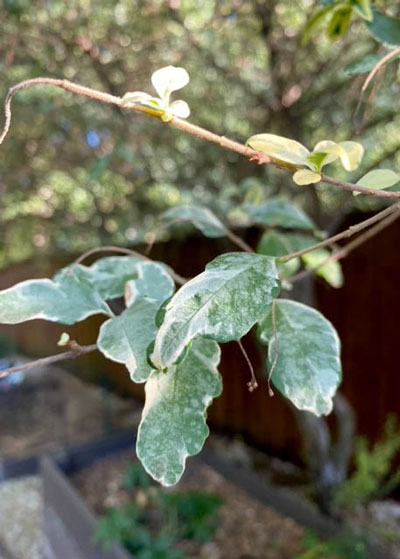
Answer: That’s powdery mildew, and I don’t believe I’ve ever seen it attack variegated privet so badly. University plant pathology websites tell us that good air circulation is the best thing we can do to stop the spread of this extremely common fungus. There are several fungicidal products sold that list powdery mildew on their labels, but most are far better as preventives than as controls. Nonetheless, I’d suggest you visit a local nursery, feed store, or hardware store and pick up one of those products and spray your plants. It looks like this problem may be with you since the plants are against the fence and pretty well shaded. I wish I had a sure-cure answer.
QUESTION 4
WHY ARE MY GRAPEVINE’S LEAVES DEVELOPING WHITE SPOTS?
Question: My grapevine was doing fine in the spring, but then the leaves started developing white spots by mid-July. The new leaves are fine while small. What is happening? Yaser I., Richardson.
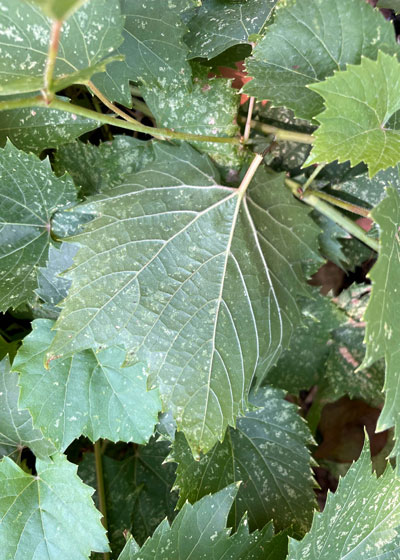
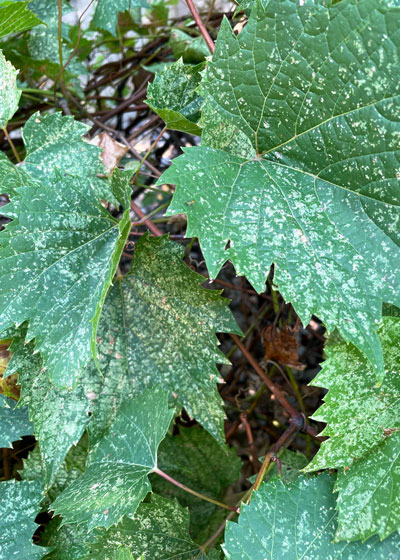
Answer: Your answer is probably visible on the backs of the leaves. Turn a few over and you may be able to find adult lacebugs or leafhoppers, as per this information from two specialists retired from Texas AgriLife Extension.
In both cases you will be able to find general-purpose fruit insecticides that can be used to stop them as soon as you see the first mottling starting to appear in mid-summer.
QUESTION 5
WHAT IS THIS PLANT, AND HOW CAN I MAKE IT GO AWAY?
Question: At first, I thought this was a daylily, then a grass, but neither seems correct. It appears to be spreading underground. What is it, and how can I get rid of it? Becky G., Sherman.
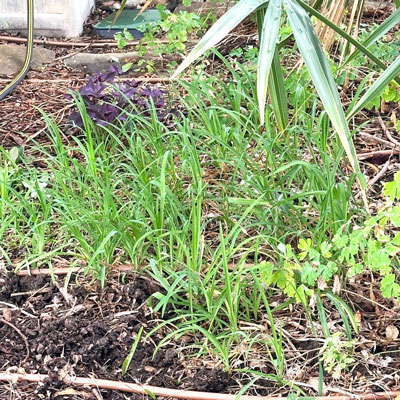
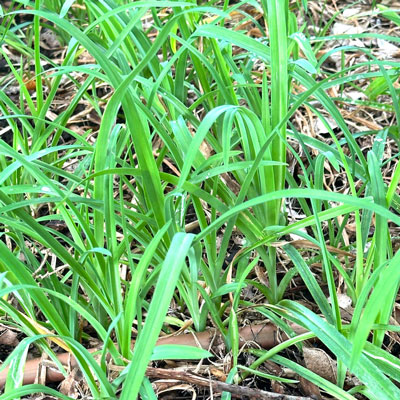
Answer: The more distant photo looks like nutsedge (“nutgrass”), but the closeup isn’t glossy enough. Here would be my step-by-step process. Dig one plant up carefully so that you have all the roots. Daylily roots will vary from one variety to another, but they typically will have swellings, and they will form distinct clumps beneath the individual plants. Nutsedge plants will have thin, dark fibers connecting one plant to the next as well as small, dark brown, coconut-like structures in the soil (the “nuts”). Their leaves will be shiny, and most importantly, their stems, when rolled between your thumb and index finger, will be triangular. That identifies sedges from grasses. Third, if it’s a grass, the stems will be round when rolled between your thumb and index finger.
Nutsedge can be controlled by application of the original Image product or Sedgehammer, although it’s getting late in the season. You will need to be careful applying those that close to other tuberous-rooted plants like your purple oxalis.
Grasses can be controlled by spraying with a glyphosate-only herbicide such as the original Roundup.
Your photos are excellent. The problem comes in that identification of plants is done mainly by flowers, fruit, and seeds, and these plants are showing none.
QUESTION 6
CAN THIS PEAR BE PRUNED BACK INTO SHAPE?
Question: Can this pear be pruned back into shape, or do I need to cut it down and start with a new one? I would really like to keep it, but I need it to be shorter so I can pick the pears. Jim I., Henderson.

Answer: Great question. Do neither. Leave it alone and invest in a long-handled harvesting tool. If you do major pruning to a pear tree you will strongly encourage fire blight to hit the vigorous regrowth. You certainly don’t want that. And to replant with a new tree in that spot will give you the same results. Your tree is tall because of the very shaded environment. You need a more wide-open area for a new tree so it can grow without being crowded.
(I suspect both you and your pup had the same expression when you saw the height of the maturing pears on your tree.)
QUESTION 7
WHAT IS WRONG WITH THE LEAVES OF MY PEACH TREE?
Question: What is wrong with the leaves of my peach tree? This is its third full year and it didn’t lose leaves like this last year. Dan S., Arlington.
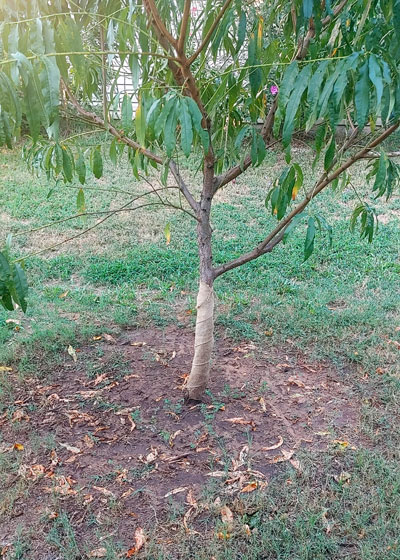
Answer: I don’t see anything at all wrong with them. It’s late August in a very hot, dry time. The tree probably grew vigorously in the wet weather this past spring and early summer, and it’s now shedding a few leaves because it can’t keep up with the demand. Keep watering and be sure to prune it this winter to encourage the spreading, bowl-shaped growth habit.
